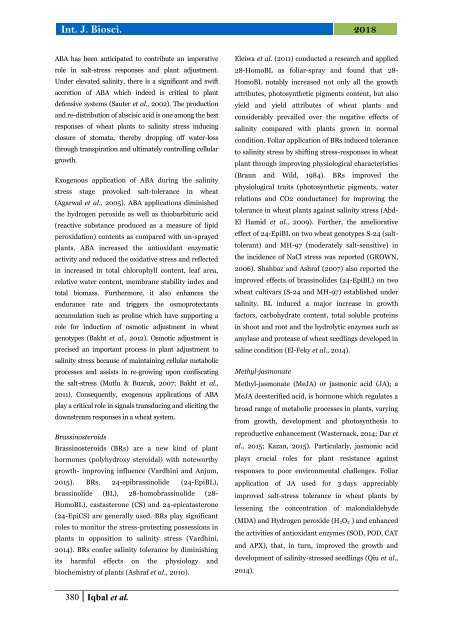Exogenous applications of plant hormones make wheat (Triticum aestivum) withstand the attack of salinity stress
Plant hormones are fundamental chemical messengers synthesized within the plants which mediate their growth and development, and also response to environmental factors. Salinity is an adverse abiotic stress that distresses the hormonal balance of plant. Consequently, these hormonal vacillations in plants adjust the cellular metabolic processes and therefore, plant hormones play a critical role in mitigating salinity-induced detrimental effects. We give an update about the role of multiple plant hormones (auxins, gibberellic acid, salicylic acid, cytokinins, ethylene, abscisic acid, brassinosteroids, methyl-jasmonate and strigolactones) to ameliorate salinity stress in wheat reap. To the best of authors’ awareness, this is first, merged, constructive review available about plant hormones role on wheat’s characteristics under salinity stress.
Plant hormones are fundamental chemical messengers synthesized within the plants which mediate their growth and development, and also response to environmental factors. Salinity is an adverse abiotic stress that distresses the hormonal balance of plant. Consequently, these hormonal vacillations in plants adjust the cellular metabolic processes and therefore, plant hormones play a critical role in mitigating salinity-induced detrimental effects. We give an update about the role of multiple plant hormones (auxins, gibberellic acid, salicylic acid, cytokinins, ethylene, abscisic acid, brassinosteroids, methyl-jasmonate and strigolactones) to ameliorate salinity stress in wheat reap. To the best of authors’ awareness, this is first, merged, constructive review available about plant hormones role on wheat’s characteristics under salinity stress.
Create successful ePaper yourself
Turn your PDF publications into a flip-book with our unique Google optimized e-Paper software.
Int. J. Biosci. 2018<br />
ABA has been anticipated to contribute an imperative<br />
role in salt-<strong>stress</strong> responses and <strong>plant</strong> adjustment.<br />
Under elevated <strong>salinity</strong>, <strong>the</strong>re is a significant and swift<br />
accretion <strong>of</strong> ABA which indeed is critical to <strong>plant</strong><br />
defensive systems (Sauter et al., 2002). The production<br />
and re-distribution <strong>of</strong> abscisic acid is one among <strong>the</strong> best<br />
responses <strong>of</strong> <strong>wheat</strong> <strong>plant</strong>s to <strong>salinity</strong> <strong>stress</strong> inducing<br />
closure <strong>of</strong> stomata, <strong>the</strong>reby dropping <strong>of</strong>f water-loss<br />
through transpiration and ultimately controlling cellular<br />
growth.<br />
<strong>Exogenous</strong> application <strong>of</strong> ABA during <strong>the</strong> <strong>salinity</strong><br />
<strong>stress</strong> stage provoked salt-tolerance in <strong>wheat</strong><br />
(Agarwal et al., 2005). ABA <strong>applications</strong> diminished<br />
<strong>the</strong> hydrogen peroxide as well as thiobarbituric acid<br />
(reactive substance produced as a measure <strong>of</strong> lipid<br />
peroxidation) contents as compared with un-sprayed<br />
<strong>plant</strong>s. ABA increased <strong>the</strong> antioxidant enzymatic<br />
activity and reduced <strong>the</strong> oxidative <strong>stress</strong> and reflected<br />
in increased in total chlorophyll content, leaf area,<br />
relative water content, membrane stability index and<br />
total biomass. Fur<strong>the</strong>rmore, it also enhances <strong>the</strong><br />
endurance rate and triggers <strong>the</strong> osmoprotectants<br />
accumulation such as proline which have supporting a<br />
role for induction <strong>of</strong> osmotic adjustment in <strong>wheat</strong><br />
genotypes (Bakht et al., 2012). Osmotic adjustment is<br />
precised an important process in <strong>plant</strong> adjustment to<br />
<strong>salinity</strong> <strong>stress</strong> because <strong>of</strong> maintaining cellular metabolic<br />
processes and assists in re-growing upon confiscating<br />
<strong>the</strong> salt-<strong>stress</strong> (Mutlu & Buzcuk, 2007; Bakht et al.,<br />
2011). Consequently, exogenous <strong>applications</strong> <strong>of</strong> ABA<br />
play a critical role in signals transducing and eliciting <strong>the</strong><br />
downstream responses in a <strong>wheat</strong> system.<br />
Brassinosteroids<br />
Brassinosteroids (BRs) are a new kind <strong>of</strong> <strong>plant</strong><br />
<strong>hormones</strong> (polyhydroxy steroidal) with noteworthy<br />
growth- improving influence (Vardhini and Anjum,<br />
2015). BRs, 24-epibrassinolide (24-EpiBL),<br />
brassinolide (BL), 28-homobrassinolide (28-<br />
HomoBL), castasterone (CS) and 24-epicatasterone<br />
(24-EpiCS) are generally used. BRs play significant<br />
roles to monitor <strong>the</strong> <strong>stress</strong>-protecting possessions in<br />
<strong>plant</strong>s in opposition to <strong>salinity</strong> <strong>stress</strong> (Vardhini,<br />
2014). BRs confer <strong>salinity</strong> tolerance by diminishing<br />
its harmful effects on <strong>the</strong> physiology and<br />
biochemistry <strong>of</strong> <strong>plant</strong>s (Ashraf et al., 2010).<br />
Eleiwa et al. (2011) conducted a research and applied<br />
28-HomoBL as foliar-spray and found that 28-<br />
HomoBL notably increased not only all <strong>the</strong> growth<br />
attributes, photosyn<strong>the</strong>tic pigments content, but also<br />
yield and yield attributes <strong>of</strong> <strong>wheat</strong> <strong>plant</strong>s and<br />
considerably prevailed over <strong>the</strong> negative effects <strong>of</strong><br />
<strong>salinity</strong> compared with <strong>plant</strong>s grown in normal<br />
condition. Foliar application <strong>of</strong> BRs induced tolerance<br />
to <strong>salinity</strong> <strong>stress</strong> by shifting <strong>stress</strong>-responses in <strong>wheat</strong><br />
<strong>plant</strong> through improving physiological characteristics<br />
(Braun and Wild, 1984). BRs improved <strong>the</strong><br />
physiological traits (photosyn<strong>the</strong>tic pigments, water<br />
relations and CO2 conductance) for improving <strong>the</strong><br />
tolerance in <strong>wheat</strong> <strong>plant</strong>s against <strong>salinity</strong> <strong>stress</strong> (Abd-<br />
El Hamid et al., 2009). Fur<strong>the</strong>r, <strong>the</strong> ameliorative<br />
effect <strong>of</strong> 24-EpiBL on two <strong>wheat</strong> genotypes S-24 (salttolerant)<br />
and MH-97 (moderately salt-sensitive) in<br />
<strong>the</strong> incidence <strong>of</strong> NaCl <strong>stress</strong> was reported (GROWN,<br />
2006). Shahbaz and Ashraf (2007) also reported <strong>the</strong><br />
improved effects <strong>of</strong> brassinolides (24-EpiBL) on two<br />
<strong>wheat</strong> cultivars (S-24 and MH-97) established under<br />
<strong>salinity</strong>. BL induced a major increase in growth<br />
factors, carbohydrate content, total soluble proteins<br />
in shoot and root and <strong>the</strong> hydrolytic enzymes such as<br />
amylase and protease <strong>of</strong> <strong>wheat</strong> seedlings developed in<br />
saline condition (El-Feky et al., 2014).<br />
Methyl-jasmonate<br />
Methyl-jasmonate (MeJA) or jasmonic acid (JA); a<br />
MeJA deesterified acid, is hormone which regulates a<br />
broad range <strong>of</strong> metabolic processes in <strong>plant</strong>s, varying<br />
from growth, development and photosyn<strong>the</strong>sis to<br />
reproductive enhancement (Wasternack, 2014; Dar et<br />
al., 2015; Kazan, 2015). Particularly, jasmonic acid<br />
plays crucial roles for <strong>plant</strong> resistance against<br />
responses to poor environmental challenges. Foliar<br />
application <strong>of</strong> JA used for 3 days appreciably<br />
improved salt-<strong>stress</strong> tolerance in <strong>wheat</strong> <strong>plant</strong>s by<br />
lessening <strong>the</strong> concentration <strong>of</strong> malondialdehyde<br />
(MDA) and Hydrogen peroxide (H2O2 ) and enhanced<br />
<strong>the</strong> activities <strong>of</strong> antioxidant enzymes (SOD, POD, CAT<br />
and APX), that, in turn, improved <strong>the</strong> growth and<br />
development <strong>of</strong> <strong>salinity</strong>-<strong>stress</strong>ed seedlings (Qiu et al.,<br />
2014).<br />
380 Iqbal et al.


















